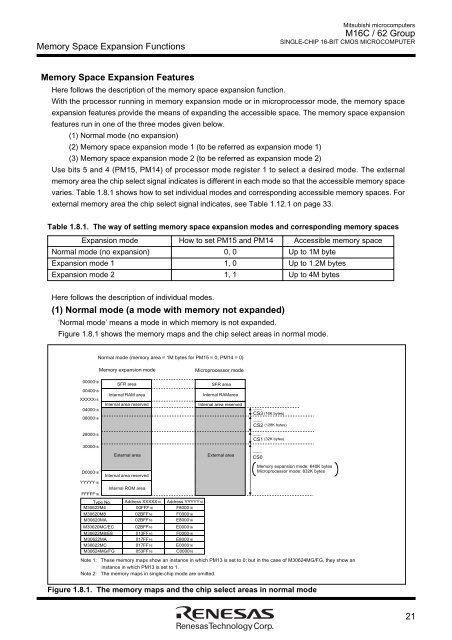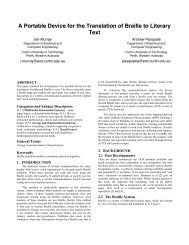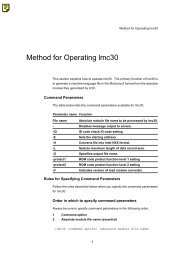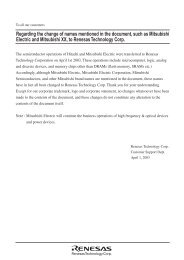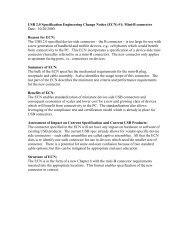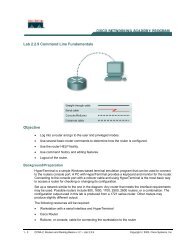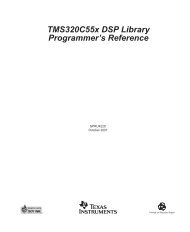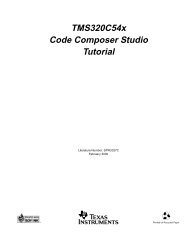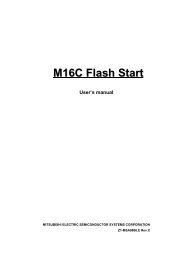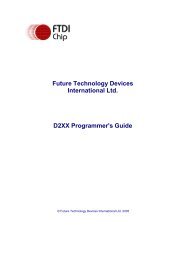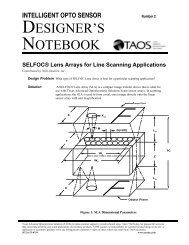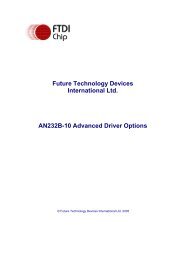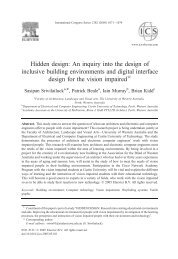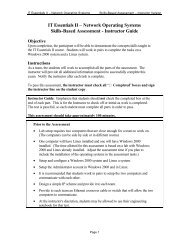- Page 1 and 2: Customer Interface Publication: KCH
- Page 3: DescriptionMitsubishi microcomputer
- Page 7 and 8: DescriptionMitsubishi microcomputer
- Page 9 and 10: Pin DescriptionMitsubishi microcomp
- Page 11 and 12: MemoryMitsubishi microcomputersM16C
- Page 13 and 14: CPUMitsubishi microcomputersM16C /
- Page 15 and 16: ResetMitsubishi microcomputersM16C
- Page 17 and 18: ResetMitsubishi microcomputersM16C
- Page 19 and 20: SFRMitsubishi microcomputersM16C /
- Page 21: SFRMitsubishi microcomputersM16C /
- Page 25 and 26: Memory Space Expansion FunctionsMit
- Page 27 and 28: Memory Space Expansion FunctionsMit
- Page 29 and 30: Processor ModeMitsubishi microcompu
- Page 31 and 32: Processor ModeMitsubishi microcompu
- Page 33 and 34: Bus SettingsMitsubishi microcompute
- Page 35 and 36: Bus ControlMitsubishi microcomputer
- Page 37 and 38: Bus ControlMitsubishi microcomputer
- Page 39 and 40: Bus ControlMitsubishi microcomputer
- Page 41 and 42: Clock Generating CircuitMitsubishi
- Page 43 and 44: Clock Generating CircuitMitsubishi
- Page 45 and 46: Clock Generating CircuitMitsubishi
- Page 47 and 48: Status Transition Of BCLKMitsubishi
- Page 49 and 50: Power controlMitsubishi microcomput
- Page 51 and 52: InterruptMitsubishi microcomputersM
- Page 53 and 54: InterruptMitsubishi microcomputersM
- Page 55 and 56: InterruptMitsubishi microcomputersM
- Page 57 and 58: InterruptMitsubishi microcomputersM
- Page 59 and 60: InterruptMitsubishi microcomputersM
- Page 61 and 62: InterruptMitsubishi microcomputersM
- Page 63 and 64: InterruptMitsubishi microcomputersM
- Page 65 and 66: InterruptMitsubishi microcomputersM
- Page 67 and 68: ________NMI InterruptMitsubishi mic
- Page 69 and 70: Precautions for InterruptsMitsubish
- Page 71 and 72: Watchdog TimerMitsubishi microcompu
- Page 73 and 74:
DMACMitsubishi microcomputersM16C /
- Page 75 and 76:
DMACMitsubishi microcomputersM16C /
- Page 77 and 78:
DMACMitsubishi microcomputersM16C /
- Page 79 and 80:
DMACMitsubishi microcomputersM16C /
- Page 81 and 82:
DMACMitsubishi microcomputersM16C /
- Page 83 and 84:
TimerMitsubishi microcomputersM16C
- Page 85 and 86:
Timer AMitsubishi microcomputersM16
- Page 87 and 88:
Timer AMitsubishi microcomputersM16
- Page 89 and 90:
Timer AMitsubishi microcomputersM16
- Page 91 and 92:
Timer AMitsubishi microcomputersM16
- Page 93 and 94:
Timer AMitsubishi microcomputersM16
- Page 95 and 96:
Timer BMitsubishi microcomputersM16
- Page 97 and 98:
Timer BMitsubishi microcomputersM16
- Page 99 and 100:
Timer BMitsubishi microcomputersM16
- Page 101 and 102:
Timers’ functions for three-phase
- Page 103 and 104:
Timers’ functions for three-phase
- Page 105 and 106:
Timers’ functions for three-phase
- Page 107 and 108:
Timers’ functions for three-phase
- Page 109 and 110:
Timers’ functions for three-phase
- Page 111 and 112:
Timers’ functions for three-phase
- Page 113 and 114:
Serial I/OMitsubishi microcomputers
- Page 115 and 116:
Serial I/OMitsubishi microcomputers
- Page 117 and 118:
Serial I/OMitsubishi microcomputers
- Page 119 and 120:
Serial I/OMitsubishi microcomputers
- Page 121 and 122:
Serial I/OMitsubishi microcomputers
- Page 123 and 124:
Clock synchronous serial I/O modeMi
- Page 125 and 126:
Clock synchronous serial I/O modeMi
- Page 127 and 128:
Clock synchronous serial I/O modeMi
- Page 129 and 130:
Clock asynchronous serial I/O (UART
- Page 131 and 132:
Clock asynchronous serial I/O (UART
- Page 133 and 134:
Clock asynchronous serial I/O (UART
- Page 135 and 136:
Clock asynchronous serial I/O (UART
- Page 137 and 138:
Clock asynchronous serial I/O (UART
- Page 139 and 140:
Clock asynchronous serial I/O (UART
- Page 141 and 142:
UART2 Special Mode RegisterMitsubis
- Page 143 and 144:
UART2 Special Mode RegisterMitsubis
- Page 145 and 146:
UART2 Special Mode Register 2Mitsub
- Page 147 and 148:
UART2 Special Mode Register 2Mitsub
- Page 149 and 150:
S I/O3, 4Mitsubishi microcomputersM
- Page 151 and 152:
S I/O3, 4Mitsubishi microcomputersM
- Page 153 and 154:
A-D ConverterMitsubishi microcomput
- Page 155 and 156:
A-D ConverterMitsubishi microcomput
- Page 157 and 158:
A-D ConverterMitsubishi microcomput
- Page 159 and 160:
A-D ConverterMitsubishi microcomput
- Page 161 and 162:
A-D ConverterMitsubishi microcomput
- Page 163 and 164:
D-A ConverterMitsubishi microcomput
- Page 165 and 166:
CRCMitsubishi microcomputersM16C /
- Page 167 and 168:
Programmable I/O PortMitsubishi mic
- Page 169 and 170:
Programmable I/O PortMitsubishi mic
- Page 171 and 172:
Programmable I/O PortMitsubishi mic
- Page 173 and 174:
Programmable I/O PortMitsubishi mic
- Page 175 and 176:
Programmable I/O PortMitsubishi mic
- Page 177 and 178:
Usage precautionMitsubishi microcom
- Page 179 and 180:
Usage precautionMitsubishi microcom
- Page 181 and 182:
Mitsubishi microcomputersM16C / 62
- Page 183 and 184:
Operating maximum frequency [MHZ]Op
- Page 185 and 186:
Electrical characteristics (Vcc = 5
- Page 187 and 188:
Timing (VCC=5V)Mitsubishi microcomp
- Page 189 and 190:
Timing (VCC=5V)Mitsubishi microcomp
- Page 191 and 192:
Timing (VCC=5V)Mitsubishi microcomp
- Page 193 and 194:
Timing (Vcc = 5V)Mitsubishi microco
- Page 195 and 196:
Timing (Vcc = 5V)Mitsubishi microco
- Page 197 and 198:
Timing (Vcc = 5V)Mitsubishi microco
- Page 199 and 200:
Electrical characteristics (Vcc = 3
- Page 201 and 202:
Timing (Vcc = 3V)Mitsubishi microco
- Page 203 and 204:
Timing (Vcc = 3V)Mitsubishi microco
- Page 205 and 206:
Timing (Vcc = 3V)Mitsubishi microco
- Page 207 and 208:
Timing (Vcc = 3V)Mitsubishi microco
- Page 209 and 210:
Timing (Vcc = 3V)Mitsubishi microco
- Page 211 and 212:
IssuancesignatureReceiptMitsubishi
- Page 213 and 214:
Mitsubishi microcomputersM16C / 62
- Page 215 and 216:
Mitsubishi microcomputersM16C / 62
- Page 217 and 218:
IssuancesignatureReceiptMitsubishi
- Page 219 and 220:
Mitsubishi microcomputersM16C / 62
- Page 221 and 222:
Mitsubishi microcomputersM16C / 62
- Page 223 and 224:
IssuancesignatureReceiptMitsubishi
- Page 225 and 226:
Mitsubishi microcomputersM16C / 62
- Page 227 and 228:
Mitsubishi microcomputersM16C / 62
- Page 229 and 230:
IssuancesignatureReceiptMitsubishi
- Page 231 and 232:
Mitsubishi microcomputersM16C / 62
- Page 233 and 234:
Mitsubishi microcomputersM16C / 62
- Page 235 and 236:
Operating maximum frequency [MHZ]De
- Page 237 and 238:
CPU Rewrite Mode (Flash Memory Vers
- Page 239 and 240:
CPU Rewrite Mode (Flash Memory Vers
- Page 241 and 242:
CPU Rewrite Mode (Flash Memory Vers
- Page 243 and 244:
CPU Rewrite Mode (Flash Memory Vers
- Page 245 and 246:
CPU Rewrite Mode (Flash Memory Vers
- Page 247 and 248:
CPU Rewrite Mode (Flash Memory Vers
- Page 249 and 250:
CPU Rewrite Mode (Flash Memory Vers
- Page 251 and 252:
Functions To Inhibit Rewriting (Fla
- Page 253 and 254:
Appendix Standard Serial I/O Mode (
- Page 255 and 256:
CNVSSRESETP93/DA0/TB3INP94/DA1/TB4I
- Page 257 and 258:
Appendix Standard Serial I/O Mode (
- Page 259 and 260:
Appendix Standard Serial I/O Mode (
- Page 261 and 262:
Appendix Standard Serial I/O Mode (
- Page 263 and 264:
Appendix Standard Serial I/O Mode (
- Page 265 and 266:
Appendix Standard Serial I/O Mode (
- Page 267 and 268:
Appendix Standard Serial I/O Mode (
- Page 269 and 270:
Appendix Standard Serial I/O Mode (
- Page 271 and 272:
Appendix Standard Serial I/O Mode (
- Page 273 and 274:
272Mitsubishi microcomputersM16C /
- Page 275 and 276:
Mitsubishi microcomputersM16C / 62
- Page 277:
MITSUBISHI SEMICONDUCTORSM16C/62 Gr


